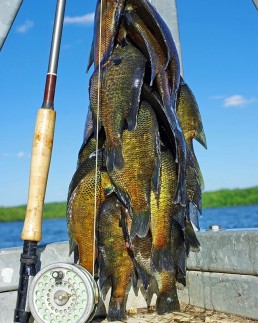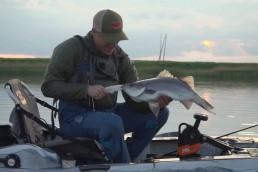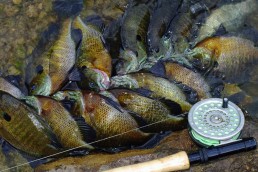Fly Fishing Illinois Bluegills: Can You Get Down with It?
SHARE THIS POST
The abundant panfish species loosely lumped under the heading of “bluegills” probably provides more budding fly anglers with their first feel of a vibrating long rod. Many go on to cast for trout, salmon and saltwater species, but some of us never grow up, even after we’re considered “experts.”
I’m that way, and my old friend Terry Wilson, formerly of Meridosa, Ill., is even more dedicated to the little scrappers. He and his wife, Roxanne, co-wrote an excellent book titled, Bluegill Fly Fishing and Flies. Like me, Terry and Roxanne have fished in many waters for many species, but they never forgot those early thrills and that unique feel of bluegills swimming in rapid circles.
“Beautiful Vibrations” is the title of the Wilson’s first chapter, and I can’t think of a better way to put it. Bluegills, indeed, are the perfect fish for a beginning fly caster. They’re eager (especially during the spring spawn) and they don’t demand accurate deliveries or delicate presentations. Most flies or small poppers will get you into the game with as much fishing action as you can find anywhere.
You can successfully fly fish for bluegills before you are able to cast very well and before you really know much about the sport. But like with many types of fishing, you can take it to more advanced levels.
Those of us who have stuck with them through advancing years and experience have concentrated our efforts toward catching the biggest bluegill and Illinois gives us plenty of places. Bluegills and other panfish inhabit most lakes, impoundments, rivers, ponds, and even the smallest waters.
What’s big? Any bluegill bigger than your hand is admirable. The Illinois bluegill record is a 3-pound, 8-ounce beauty caught in a farm pond in Jasper County in 1987. Even though redear sunfish generally grow much larger than bluegills, the biggest redear ever recorded in Illinois was a 2-pound, 12.3-ounce fish taken in Marion Country Club Lake in Williamson County in 1985.
Either is up for grabs, but the redear record could—and should—be broken. A fly fisherman has as much chance of breaking either of these records as a worm or cricket fisherman because bluegills not only provide the perfect target for a beginner, but a fly rod is the most effective tool I’ve found for catching the big ones.
You can get a lot of sound advice about the aspects of fly fishing for bluegills from Terry and Roxanne’s book, but the best general advice for more and bigger panfish, is to “get down.”
Everyone thinks of some sort of surface offering when casting a fly rod to bluegills, but I learned decades ago that I could catch more, bigger bluegills with something that sinks. This is true for bluegills and redear sunfish. This is my favorite of the sunfish family, and I love to catch these bruisers on a long, limber rod.
Many fly fishermen claim you can’t catch redear with a fly rod, but I suspect they’ve never really scratched the surface on this subject—literally. Redear are notorious bottom-feeders, and they spend most of the year in relatively deep water. But during spring they move shallow to spawn and feed, and are susceptible to a fly. They don’t often rise to the surface, so I guess that’s why some fly fishermen think they are hard to catch. But if you’ll let a weighted fly sink to them, they’ll take it without hesitation and hightail it for deeper water. They don’t swim in little circles like bluegills; they bore straight away with bullish intent. All weighted nymphs and wet flies work for redear—as long as the color is black.
I think black works best for all panfish, but especially redear because their main diet is small snails and other mollusks, and all these shells are dark-gray to black. Alabama boys who have a passion for redear gave them the second most common name of “shell crackers” many years ago. The reason is, redear have a rather unique set of molars on their pharyngeal arches (throat) and muscles strong enough to crack the shells of small snails. The Alabama state record redear is 4 pounds, 4 ounces, while the world-record redear is an unimaginable 5-pounds, 7 1/2-ounces caught in South Carolina.
Redear also eat small fish and some insects, so black obviously isn’t the only color that works. But they feast on black creatures, so it’s the color they’re most accustomed to eating.
I’ve found weighted black fur ants tied on #12 or #14 wet fly hooks are equally attractive to bluegills and redear. Terry Wilson designed his own line of “Bully’s Bluegill Flies”—another weighted sinker that works.
Any fly rod outfit works for bluegills, but a matched five- or six-weight outfit is ideal. You don’t have to spend a fortune, either. Good, inexpensive graphite fly rods and single-action reels are common these days.
I would, however, suggest you invest in a good, double-taper fly line and quality leaders. A tippet with test around 4 pounds is about right. You can go lighter if you know what you’re doing. You especially want a good floating fly line and a little fly line dressing to keep it floating well because this is your strike indicator when fishing sinking flies. (Various “strike indicators” are made that attach to the end of a fly line, but these make casting more difficult, so learn to watch the end of your fly line instead.)
Are you enjoying this post?
You can be among the first to get the latest info on where to go, what to use and how to use it!
High-visibility fly lines help, but watching the fly line to detect strikes is not as difficult as you might think. Most of the time, bluegills and redear both snatch a fly and take off with it, moving the line quickly and considerably. This is because they are naturally aggressive in the first place, and travel and spawn in large schools. They compete with each other for available food and don’t like to share.
The leader should be between 6 and 9 feet long, depending upon how deep you expect the redear to hang out. As a general rule, use a leader that is twice the depth you plan to fish. Preferring cooler water, redear move into to spawn earlier than bluegills, but both species go in 2 to 4 feet, so a 6-foot leader is fine for that.
They also hang around the shallows for a few more weeks to feed upon the spawn of other sunfish relatives and their own offspring. During this period, up until the water gets uncomfortably warm for them, they hang out on the deeper edges of the spawning beds. By casting beyond the bluegill beds and allowing your flies to sink to 5 or 6 feet, you can pick up these opportunistic predators.
In any case for either species, the presentation of weighted flies is the same: after casting, allow the fly time to sink. (I use a countdown method based upon how fast the fly sinks and how deep I want it to get before imparting any retrieve.) And as it sinks, pay close attention to the end of the fly line because they often snatch it on the fall.
Once the fly reaches your intended depth, retrieve the line slowly and steadily with a hand-twist retrieve. If you don’t know how to do that, use short, 6-inch strips of the line. The key is to retrieve it slowly. Fly fishing is so effective for panfish not because of the way the line is delivered or because of any “match-the-hatch” aspect, but because of its unique presentation qualities during the retrieve. Once you impart a retrieve, weighted flies quit sinking, even on the slowest retrieve, and the slower you can go the more time it spends in the strike zone.
Little bluegills and redear are like most small species: they’re very impetuous and aggressive. The bigger members on the other hand, have learned to expend the least energy for the maximum calories ingested. They don’t chase things around; they ambush. So, slower flies get more of their attention.
One final piece of advice: Don’t spend too much time in one place, especially when casting to spawning panfish. The unavoidable commotion of catching a few from one spot alerts the others that something is wrong. Some get the message as soon as they see their brothers acting so crazy and then vanish mysteriously.
All fish, including bluegills, secrete an alarm scent when hooked, and when a few of them put this stress odor into the shallow, still waters of a spawning area, the whole group gets the message. Some of them scatter, but all of them become nervous and cautious. It ruins the spawning “mood.”
If you sit there and wait long enough, as bobber fishermen do, the bluegills will settle down and start biting again. But this can take anywhere from 30 minutes to a couple of hours. Fly fishermen are more likely to move to another spawning area to find more willing quarry. Those who catch the most know three or four spawning sites. They rotate through them, casting to active fish almost all the time, and by the time they circle back to the first one, the fish are rested and ready again.
So you see, fly fishing for bluegills is the perfect sport for beginners and experts alike. Those “beautiful vibrations” never fade—they just get bigger.
Ron Kruger has been communicating the outdoor experience for over four decades. He has worked as a full-time guide for trout on the North Fork, for crappies and bass on Kentucky Lake and for smallmouths on the Current River. He has served as editor of three outdoor magazines, and owns a patent on a fly/lure called the Desperate Diver.
MWO
SHARE THIS POST
Did you enjoy this post?
You can be among the first to get the latest info on where to go, what to use and how to use it!
Ron Kruger
Ron Kruger has been communicating the outdoor experience for more than four decades. He has worked as a full-time guide for trout on the North Fork, for crappies and bass on Kentucky Lake and for smallmouths on the Current River. He has served as editor of three outdoor magazines, and owns a patent on a fly/lure called the Desperate Diver.



